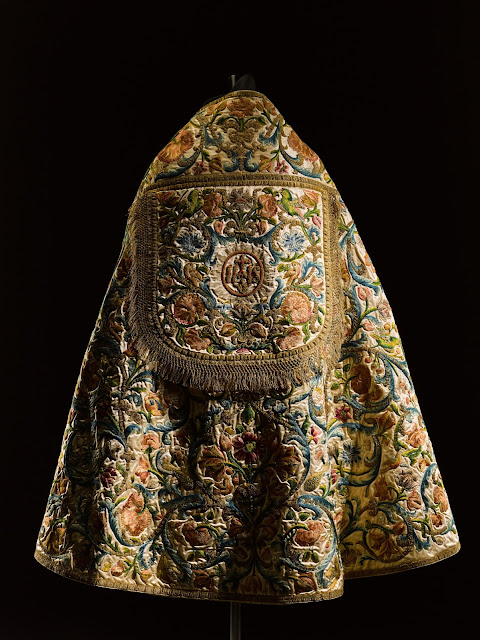As we often like to do here each springtime and Eastertide, it is time to feature a vestment in the Roman tradition of the same; vestments which feature colourful, pastel coloured floriated designs according to the aesthetic of the seventeenth and eighteenth century. As we've pointed out before, these vestments are playful, joyful and thus festal in nature, being frequently associated with the liturgical season of Easter (with its imagery of renewal and resurrection, a theme also repeated by the season of spring when winter is surpassed and flowers and such begin anew) as well as Marian feasts (who, since medieval times, has so very often been symbolized by various flowers). It is a beautiful tradition and -- in my estimation -- particularly beautifully expressed in the seventeenth and eighteenth centuries (for by the nineteenth, Victorian tastes had shifted over toward darker colours in this sort of work).
Today we are showing a cope coming from this tradition. It was actually produced in the nineteenth century by the atelier of Giovanni Romanini, but purposefully done in an eighteenth century style. The embroidery is done in polychrome silk threads and amidst the various floriated elements can also be found birds, butterflies and colourful moths.
The shield contains a wonderfully restrained IHS monogram coming from the Jesuit tradition, complete with red Italian coral decoration. This is, in point of fact, a good lesson for contemporaries. Too often it is popularly thought today that symbols and pictures must be done in such a way that they should either be numerous or very large so as to be the primary focus, but that is not necessarily the case and can come at the risk of becoming gaudy or tacky. In this instance we see it serve as an accent -- one that does not find itself competing with the rest of the design, integrating itself into it, but which is all the same notable by its prominent placement.
It is worth noting that this same atelier is also notable for having produced a red papal mantum for Pope Leo XIII in the year 1879 and another in white. It is also speculated they produced another for Pope Benedict XV and another for Pope John XXIII. In this regard, they were certainly one of the pre-eminent ateliers operating in Rome in these centuries, alongside others like Ditta Gammarelli.
-------
Do you like Liturgical Arts Journal's original content? You can help support LAJ in its mission and vision to promote beauty in Catholic worship either by:
You choose the amount! Your support makes all the difference.
















